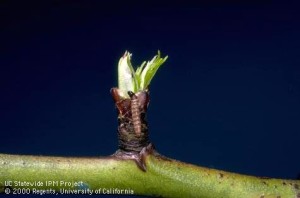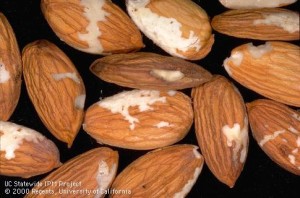Written by John Edstrom, UCCE Farm Advisor Colusa County, Emeritus

Hopefully, the central valley will finally receive drought relief from recent El Niño driven storms. The resulting wet soil conditions, however, can prevent orchard access for many orchard operations including dormant sprays. Without dormant insecticide sprays, peach twig borer (PTB) populations can increase dramatically and threaten next years crop. Worm reject levels were troublesome and costly to many almond growers this past season and point to the need to control PTB. Besides kernel damage, twig borer feeding also kills young buds and shoot tips after bloom and deforms young tree scaffold limb development .
Fortunately, growers have a very safe alternative to dormant sprays using Bacillus thuringiensis (or Bt) to control PTB during the bloom season without harmful side effects to applicators or the environment. Other insecticidal materials claim to be safe to bees but may negatively impact bee colony health. Bt has no adverse affects to any stage of honeybees or the health of the hive. Bt is a natural bacterial based insecticide that is toxic only when ingested by lepidopteran larval stage pests and is completely safe to beneficial predators and parasitoids. Bt is exempt from pesticide use regulations and so is particularly useful near urban or environmentally sensitive areas. The bloom Bt control strategy has proven effective since its was developed in the 1990s during a time when regulations were restricting the use of the highly toxic organophosphate spray materials.

Bt is a perfect fit for almond IPM programs. Its only down side is that multiple applications are needed for complete control. Fortunately, Bt products are inexpensive and can be tank mixed with fungicides applied for blossom and leaf diseases around bloom, so the total costs are comparable or less than standard insecticides. Generally, two sprays are needed to cover the emergence period of the overwintering PTB worms as they crawl out from under the bark to feed on flowers and developing shoot tips. The original field research showed that good control was obtained when tank mixed with the full bloom and petal fall sprays. However, during seasons when flowering and early shoot growth is protracted, a 3rd application maybe needed to completely cover the PTB emergence/feeding period. Given our intensified disease control spray programs a tank mix is also possible at this time.


Considerations for 2016 Bloom - The Almond Doctor
February 15, 2016[…] careful with bees. Do not tank mix in any insecticides for PTB besides Bt. Pesticides applied at this time do not control Navel Orangeworm. Do what is possible to reduce […]